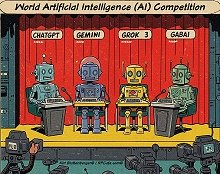Electronics & Technology
- See Full List of AI Topics -
Zinc oxide (ZnO) is a widely used piezoelectric material that exhibits the ability
to generate an electric charge in response to mechanical stress and vice versa.
It is a binary compound composed of zinc and oxygen atoms and is known for its wide
bandgap, high thermal stability, and good optical properties.
In terms of piezoelectric properties, ZnO has a relatively high piezoelectric
coefficient, making it a popular choice for a variety of applications, including
sensors, transducers, actuators, and energy harvesting devices. Its piezoelectric
properties make it useful for converting mechanical energy into electrical energy,
which is useful in applications such as pressure sensors and accelerometers.
ZnO is also a nontoxic and environmentally friendly material, which makes it
a more desirable choice for applications where toxicity is a concern, as compared
to other piezoelectric materials such as lead-based materials.
In addition to its piezoelectric properties, ZnO is also a promising material
for other applications such as optoelectronics, photovoltaics, and catalysis, due
to its unique optical and electronic properties. As a result, it has become a popular
material in various fields of research, and there is ongoing effort to optimize
its properties for various applications.
 This content was generated by primarily
the ChatGPT (OpenAI), and/or
Gemini (Google), and/or
Arya (GabAI), and/or
Grok 3 (x.AI) artificial intelligence (AI) engine.
Some review was performed to help detect and correct any inaccuracies; however,
you are encouraged to verify the information yourself if it will be used for critical
applications. In some cases, multiple solicitations to the AI engine(s) was(were) used to assimilate
final content. Images and external hyperlinks have also been added occasionally.
Courts have ruled that AI-generated content is not subject to copyright restrictions,
but since I modify them, everything here is protected by RF Cafe copyright. Many
of the images are likewise generated and modified. Your use of this data implies
an agreement to hold totally harmless Kirt Blattenberger, RF Cafe, and any and all
of its assigns. Thank you. Here are the major categories. This content was generated by primarily
the ChatGPT (OpenAI), and/or
Gemini (Google), and/or
Arya (GabAI), and/or
Grok 3 (x.AI) artificial intelligence (AI) engine.
Some review was performed to help detect and correct any inaccuracies; however,
you are encouraged to verify the information yourself if it will be used for critical
applications. In some cases, multiple solicitations to the AI engine(s) was(were) used to assimilate
final content. Images and external hyperlinks have also been added occasionally.
Courts have ruled that AI-generated content is not subject to copyright restrictions,
but since I modify them, everything here is protected by RF Cafe copyright. Many
of the images are likewise generated and modified. Your use of this data implies
an agreement to hold totally harmless Kirt Blattenberger, RF Cafe, and any and all
of its assigns. Thank you. Here are the major categories.
Electronics & High Tech
Companies | Electronics &
Tech Publications | Electronics &
Tech Pioneers | Electronics &
Tech Principles |
Tech Standards Groups &
Industry Associations | Societal
Influences on Technology
|







